These are the notes for the discussion at the 2-day Kīrtan party at Ter Kabamba Mandir.
How to Realize Your Relationship with Reality
This is the second of three discussions presenting the essential foundations of Indian philosophy, especially the Bhedābheda Vedānta Darśan school of bhakti-yoga.
In the previous discussion we established that three things really exist: (1) consciousness – you, (2) objects of consciousness – the world, and (3) the source of both – the Supreme Being. We established that consciousness is always searching for something, but never finds it in the external objects of consciousness. Consciousness is searching for happiness, and happiness is epitomized as love.
Now we will discuss how consciousness can realize the happiness and love it eternally seeks.
Three Types of Yoga
The Sanskrit word yoga literally means “union” and is mainly used to describe a path that leads the consciousness to realize its beautiful relationship with reality. There are many, many types of yogas described in Sanskrit literature, but all of them fall into one of three broad categories:
Paths of action (karma-yoga)
Paths of philosophy (jñāna-yoga)
Paths of love (bhakti-yoga)
All three free our hearts from selfishness, bringing us to a state in which real love, real happiness, is possible.
The paths of action do it by regulating our daily life through moral rules and rituals. The paths of philosophy do it by examining the world and learning to see that we cannot control or possess anything in it. The paths of love do it by transforming our desires and emotions.
Yogas don’t fight and compete with one another like modern religions do. They help and support one another. The most effective combination is when the paths of action and philosophy support and assist the paths of love. The paths of love are central and most important. The reason is obvious: the light of our consciousness is searching for the happiness of love, therefore the paths of love are the most relevant and essential of all the yogas.
The Beloved
First of all, love requires a beloved!
The light of consciousness is constantly searching for the beloved, but so long as our search is limited to the external objects of consciousness, we search in vain. When our searchlight looks inward, towards to root of its own light, it finds īśvara. Then we will finally have found the ultimate beloved, for īśvara, being the self of our self, is the only object we can ever truly possess.
The most affectionate and intimate form of īśvara is addressed with names like “All-Attractive” (Krishna), “All-loving” (Rāma), and “Heart-stealing” (Hari). This being, Krishna, is is the perfect beloved for the yoga of love.
Definition of Love
Śrī Rūpa Goswāmī is one of the most important founders of the Bhedābheda Vedānta Darśan school of bhakti-yoga. His detailed explanation of the yoga of love, a book entitled Bhakti Rasāmṛta Sindhu is cherished as the most definitive text on the subject. He begins by defining what love is:
आबुकूल्यन कृष्णानुशीलनं भक्तिः
ānukūlyena kṛṣṇānu-śīlanaṁ bhaktiḥ
“Love is an expression of desire to please the beloved, Krishna.”
Love therefore has two components:
A feeling (the feeling of wanting to please the beloved)
An action (the practical ways we express our feeling)
Śrī Rūpa goes further and defines true love, pure love, uttama-bhakti:
अन्याभिलाषिताशून्यं ज्ञानकर्माद्यनावृतम्
anyābhilāṣitā śūnyaṁ jñāna-karmady anāvṛtam
“Pure love has no ulterior motive
and is not distracted by ulterior interests.”
Love is pure when both the feeling and the action are pure. Ie:
There is no ulterior motive. The desire to please the beloved is the only feeling motivating the action.
The expression is completely for the pleasure of the beloved. It isn’t eclipsed by distractions.
To practice the yoga of love, we simply cultivate feelings for Krishna and express them, but we do it without any ulterior motive or distraction for personal gain. We are not practicing the yoga to gain any blessing or liberation, other than the pure bliss inherent in the pure love itself.
“Practicing Love”?
A popular English saying is, “Practice makes perfect.” There are two stages in the yoga of love: practice and perfection. For the rest of this discussion, we’ll learn about how to practice the yoga of love. In our next discussion we’ll learn about the yoga of love in perfection.
Śrī Rūpa defines the practice of love as:
कृतिसाध्या भवेत् साध्याभावा सा साधनाभिध ।
नित्यसिद्धस्यभावस्य प्राकट्यं हृदि साध्यता ॥
kṛti-sādhyā bhavet sādhya-bhāva sā sādhanābhidhā
nitya-siddhasya bhāvasya prākaṭyaṁ hṛdi sādhyatā
“The desired emotions arise from emulating them
- this is known as the ‘practice of love.’
The result is that eternally perfect love manifests in the heart.”
“Practicing love” may sound artificial, but the idea is that by practicing the feelings and actions of love, our hearts become free from the selfishness that blocks such feelings and actions from naturally arising.
How to Practice Divine Love
Śrī Rūpa defined 64 ways to practice the yoga of divine love. Today we will explain the three most important preliminary practices, and the five that are the most powerful of all the practices.
Three Essential Preliminaries
To effectively practice the yoga of love, the first thing we have to do is गुरुपादाश्रयः (guru-pādāśrayaḥ). We have to seek people who are significantly more advanced in the yoga than we are.
Next is कृष्णदीक्षादिशिक्षणम् (kṛṣṇa-dikṣādi-śikṣaṇam). After finding such people, we have to try our best to learn from them everything we possibly can about Krishna. We should ask to receive from them the various Krishna-mantras and so on that greatly aid the practice of divine love.
The third preliminary practice is विश्रम्भेण गुरोः सेवा (viśrambheṇa guroḥ sevā), we should try to tirelessly express our gratitude for the guidance and inspiration we get from these people.
We hold these kīrtana parties to grant one another the opportunity to more easily practice these first three preliminaries. Here we can find people who are more serious than us about the yoga of love, and we can speak with them and seek their guidance and help. We can express our gratitude by participating helpfully and wholeheartedly in the party by bring gifts like fruits and flowers or simple donations for Śrīmatī Rādhārāṇī, our ultimate guru.
Five Most Powerful Practices
Śrī Rūpa says:
दुरूहाद्भुत वीर्ये ऽस्मिन् श्रद्धादूरे ऽस्तु पऩ्चके। यत्र स्वल्पो ऽपि सम्बन्धः सद्धियां भावजन्मने॥
durūhādbhuta vīrye ‘smin śraddhā dūre ‘stu pancake,
yatra svalpo ‘pi sambandhaḥ sad-dhiyaṁ bhāva-janmane
“These five practices possess impossibly amazingly potency. Even if one doesn’t have that much faith in them and only practices them with slight concentration – still they bring the perfection of divine love.”
The five most powerful practices are the five things most essential to evoking love: beauty, poetry, friendship, music, and the right atmosphere.
Beauty
We expose ourselves to divine beauty by looking at the deity and the paintings of Krishna.
Śrī Rūpa says, “Affectionately offer small, humble service to Krishna’s beautiful manifest form.” Śrī Śrī Nandini Nandana have so kindly manifest their form here in Japan just so we can be attracted by their divine beauty. Think of some small way you can do something for them: cooking something delicious for them, sewing or buying some beautiful ornament or decoration, etc.
स्मेरां भन्गीत्रयपरिचितां साचि विस्तीर्णद्रिष्टिं। वंशीन्यस्ताधरकिशलयामुज्ज्वलां चन्द्रकेण।
गोविन्दाख्यां हरितनुम् इतः केशितीर्थोपकण्ठे। मा प्रेक्षिष्ठास् तव यदि सखे बन्धु-सन्गे ‘स्ति रन्गः॥
smerāṃ bhangī-traya-paricitāṃ sāci vistīrṇa-driṣṭiṃ
vaṃśī-nyastādhara-kiśalayām ujjvalāṃ candrakeṇa
govindākhyāṃ hari-tanum itaḥ keśi-tīrthopakaṇṭhe
mā prekṣiṣṭhās tava yadi sakhe bandhu-sange ‘sti rangaḥ
Smiling, in his amazing triple-bending posture,
with his expanding sidelong glance
With newly blossomed lips set upon his flute,
that shines so brightly in the moonlight.
This form of Hari called “Govinda”
eagerly awaits you in Vṛndāvana.
My friend, don’t go there!
You will give up your love for everything else if you do!
The idea in this poem is that if we affectionately serve the beautiful deities of Krishna, we will experience a happiness that will soon make us forget everything else we were once so interested in.
Poetry
Śrī Rūpa says, “relish the meaning of the beautiful Bhāgavatam.”
शन्के नीताः सपदि दशमस्कन्धपद्यावलीनां। वर्णाः कर्णाध्वनि पथिकताम् आनुपूर्व्याद् भवद्भिः।
हंहो डिम्भाः परमशुभदान् हन्त धर्मार्थकामान्। यद् गर्हन्तः सुखमयम् अमी मोक्षम् अप्य् आक्षिपन्ति॥
śanke nītāḥ sapadi daśama-skandha-padyāvalīnāṃ
varṇāḥ karṇādhvani pathikatām ānupūrvyād bhavadbhiḥ
haṃho ḍimbhāḥ parama-śubhadān hanta dharmārtha-kāmān
yad garhantaḥ sukhamayam amī mokṣam apy ākṣipanti
Oh what a fool you are, child!
The sounds of the letters of the poems of the tenth canto
seem to have traveled the pathways to your ears.
Now you no longer care about what everyone considers important:
Pleasure, prestige, morality…
You even discard the bliss of liberation!
Poetry expressing divine love is extremely important in the practice of the yoga of love. The most important book of such poetry, the mother of them all, is called Bhāgavata. It is full of beautiful poems about Krishna. If you dive into the sweet ocean of these poems, you will soon find yourself drowning in an ocean of unlimited happiness, completely forgetting everything else that once fascinated you!
Friends
Śrī Rūpa says, “Become close with the beautiful lovers of Krishna, especially those who are similar to you, can help you, and who naturally like you.”
द्रिगम्भोभिर् धौतः पुलकपतली मण्डिततनुः। स्खलन् नन्तः फुल्लो दधद् अतिप्रिथुं वेपथुम् अपि।
द्रिशोः कक्षां यावन् मम स पुरुषः को ‘प्य् उपययौ। न जाने किं तावन् मतिर् इह ग्रिहे नाभिरमते॥
drig-ambhobhir dhautaḥ pulaka-patalī maṇḍita-tanuḥ
skhalan nantaḥ phullo dadhad atiprithuṃ vepathum api
driśoḥ kakṣāṃ yāvan mama sa puruṣaḥ ko ‘py upayayau
na jāne kiṃ tāvan matir iha grihe nābhiramate
Bathed in tears,
Decorated by blossoms of goose-bumps,
Shivering,
Stumbling under the weight
of a fully-blossomed, overflowing heart…
Since I saw that person,
I can’t enjoy anything ordinary.
Why?
When we meet people who are very deeply moved by the yoga of love, our whole life changes. We lose interest in everything else and seek to attain the sublime happiness we witnessed in those people. Three things are very important in making friendship with devotees: sājātiya, we should have some things naturally in common; āśaya, they should be capable of helping us in our practice of devotion; snigdha – they should be willing to help us. Whenever you find all three qualities in a person, it is very important to become very close friends with them.
Music
Śrī Rūpa says, “Celebrate the name of beloved Krishna with music and dancing.”
यदवधि मम शीता वैणिकेनानुगीता। श्रुतिपथमघ-शत्रोर् नामागाथा प्रयाता।
अनवकलितपूर्वां हन्त कामप्यवस्थां। तदवधि दधदन्तर्मानसं शाम्यतीव॥
yadavadhi mama śītā vaiṇikenānugītā
śruti-patham agha-śatror nāmā-gāthā prayātā
anavakalita-pūrvāṃ hanta kām apy avasthāṃ
tadavadhi dadhad antarmānasaṃ śāmyatīva
The cooling sound of that musician’s song
graced the path of my ears,
Glorifying the Name,
destroying all misfortune.
Oh, my dear, at that moment
the Name overwhelmed my inner mind
And erased everything it once held dear.
This is the main practice of the yoga of love – singing the name of the beloved. That’s why it is the main focus of our monthly kīrtan parties. If we regularly sing Krishna’s name, from the heart, we will quickly taste the bliss of divine love – and thus experience a happiness that will make us forget everything else we once thought was so exciting.
The Right Atmosphere
Śrī Rūpa says, “live in Vṛndāvana.” He writes:
तटभुवि क्रित कान्तिः श्यामलायास्तटिन्याः। स्फुटितनवकदम्बालम्बिकूजद्द्विरेफा।
निरवधिमधुरिम्ण मण्डितेयं कथं मे। मनसि कमपि भावं काननश्रीस् तनोति॥
taṭa-bhuvi krita kāntiḥ śyāmalāyās taṭinyāḥ
sphuṭita-nava-kadambālambi-kūjad-dvirephā
niravadhi-madhurimṇa maṇḍiteyaṃ kathaṃ me
manasi kam api bhāvaṃ kānana-śrīs tanoti
That splendid, golden place
On the bank of a blue-black river
Where bees hum sonorously around trees heavy with Kadamba flowers…
Why does this heavenly forest decorate my mind
with such inexpressible sweetness?
We hope that you will always help us celebrate our kīrtana parties because here we can very easily enjoy the five most powerful practices of the yoga of love. Coming into this room we enter the spiritual atmosphere of Vṛndāvana. Speaking with the people here, we develop deep friendship with those who love Krishna. Hearing the discussions we come to understand the meaning of the poems of Bhāgavatam. Seeing the deities and paintings, we get some idea of the beautiful form of Krishna. And as we play music and sing Krishna’s name together it all conspires to form a powerful vehicle for our spiritual evolution towards realizing the true happiness that the light of our consciousness has always searched for.
The Most Powerful Way to Practice
Śrī Rūpa explains that there are two ways to practice the yoga of love, one is out of obedience to the logic of it, and the other is as a result of your own specific love for it. Obviously the second way is more pure and faithful to the nature of what the yoga of love is in the first place. It is the most powerful way to practice this yoga.
To practice the yoga of love this way, you must hear enough about Krishna that you will be able to recognize within your heart a natural love and special affection for a certain kind of relationship with him. Then, you can invest your external practices with internal significance. In your heart and mind you envision yourself doing those same practices and activities as a part of the relationship with Krishna that your heart naturally desires.
This method is called rāgānugā-bhakti. It is the primary focus of practitioners in the Bhedābheda Vedānta School of bhakti-yoga.
日本語:あなたと真実の関係を悟る方法
特に Bhedābheda Vedānta Darśan 宗派において、これはインド哲学の本質的基本を伝える三つの議論第二番目です。
以前の話しでは 3つのことが本当に存在することを確証しました: 1.意識(本当のあなた自身)2.意識の対象(物質)3.両者の根源(上天)。意識はいつも何かを求めていますが、意識の対象物に何かを見つけることは決してできないようだと証明しました。意識はいつも何かを探してる。でも物質からそれを見つけることは決してできないということを確認しました。意識は幸せを探していてその幸せは愛を要約するものだということを悟りました。
さて今、私たちはどのようにして意は幸せを得ることができ、永遠に求めている愛を得ることができるのかという話し合いをしましょう。
三つ種類のヨーガ
サンスクリットの言葉でヨーガというのは文字通り結合(ユニオン)という意味であり、主に意識が本当の美しい関係を悟れるように先導する方法を説明しています。沢山あってサンスクリットの教典では100のヨーガでさえ説明されています。でもこれらすべてのヨーガは大きく分けた3つの種類に分散されます。(1) 活動によっての方法 – karma-ヨーガ; (2) 知識によっての方法 – jñāna-ヨーガ; (3) 愛によっての方法 – bhakti-ヨーガ.
すべての三つは利己的な私たちの心を浄化することは愛を妨げる主な障害物を取り除く助けをしてくれます。
活動の方法は、道徳的規則やしきたりを通じて私たちの日常生活によって行われているものです。知識の方法は、世界を検討したり、私たちは何も所有することができず、支配することもできないことを学ぶことによって、行われているものです。愛の方法は、私たちの望みや感情を変換することによって、行われているものです。
ヨーガは現代の宗教がするように他のものと競争したり、争い合ったりしません。ヨーガはお互いに助け合ったり支援しあいます。最も効果的な組み合わせは、カルマヨーガとギャーナヨーガがバクチーヨーガを支え助ける時です。愛の方法は、最も重要で中心的なものです。その理由は明白です。私たちの意識の明かりは愛の幸せを探し求めています。ですから愛の方法は最も重要ですべてのヨーガの真髄です。
恋しい
まず最初に愛は愛する人を必要とします!意識の明かりは常に愛する人を探し続けています。でも意識が外的な対象物に限って求めている限り、努力は報われません。内向きに見ると、本当の自分の源Īśvaraを発見します、 Īśvara. そして私たちが大昔から探し続けたことがついに成功するでしょう。最も愛情のこもった、内密な Īśvaraの姿はKrishnaと言う名前(「すべてを魅了するお方」)やRāma (「すべての恋しいお方」)やHari(「ハート泥棒」)。Krishnaは愛のヨーガにおいて完璧な愛するお方です。
愛の定義
Śrī Rūpa Goswāmī は愛のヨーガで最も重要な創業者の一人。彼の Bhakti Rasāmṛta Sindhuと言う名前の本は愛のヨーガで一番大切な本です。この本は、愛の定義から始まります.
आबुकूल्यन कृष्णानुशीलनं भक्तिः
「愛は愛しいKrishnaを喜ばせたい望みの表現だ」。
ですから愛は二つの要素で構成されています。1. 感情(最愛の人を喜ばせたいと思う感情)2. 行動(私たちの感情を表現する実践的方法)
Śrī Rūpa はさらに深く進んで本当の愛、純粋な愛 (uttama-bhakti)を定義しています。
अन्याभिलाषिताशून्यं ज्ञानकर्माद्यनावृतम्
「純愛は他心や憂晴しがない愛」
感情と行動の両者が本物で純粋なとき、愛は本物で純粋になります。1. 隠された動機がない。愛する人を喜ばせたいという望みが唯一行動の動機としての感情です。2 表現が完全に愛する人を喜ばせたいというためだけなんです。何事にも気をとられず耐えまなく。
愛のヨーガを練習するための方法は簡単。Krishnaのための感情を養う、でも他心なしでそれを行う。愛は私たちが神から必要な唯一のものです。個人的な利益を求める動機も同様も何もないのが愛ヨーガです。愛は非常に大切な宝物なので、その他の全ての宝物はバクティーヨーガに含まれています。このように、ただKrishnaの喜びのためだけに愛のヨーガを修練することで、修行者は何者にも変えられない幸福を得るので、物質的或いは精神的計算によって推し量ることは決してできません。
「愛を訓練する」?
英語に「訓練は完成を作る」という有名な言い回しがあります。愛のヨーガでは、ほとんど全ての中にあるように2つの段階、つまり訓練と完成があります。今回の話題は愛の訓練。次回は愛の完成。
Śrī Rūpa が愛訓練の定義する:
कृतिसाध्या भवेत् साध्याभावा सा साधनाभिध । नित्यसिद्धस्यभावस्य प्राकट्यं हृदि साध्यता ॥
「本当の感情がそれを模倣することによって起こる
これは「愛訓練」と言う。
結果は永遠に完全な愛が心の中に明らかにする。」
”愛を訓練する”という言葉は何か不自然に聞こえます。でも、愛の行動と感情を訓練することによって、自然にそして完全に目覚めようとする感情や行動を妨げる利己心から私たちの心を解放します。
神聖な愛の訓練のしかた
Śrī Rūpa は神聖な愛ヨーガ訓練を64の種類に定義しています。今日は最も重要な3項目の準備段階の修練と、そしてすべての訓練のうちで最強の5項目について説明しましょう。
3つの本質的準備段階
本当に愛のヨーガを訓練は、まずguru-pādāśrayaḥ から始めなければなりません。このヨーガにおいて少なくとも自分よりすっと優れた人を探す必要があります。
次に、kṛṣṇa-dikṣādi-śikṣaṇamの人を探さなければいけません。このような人を見つけた後、その人からクリシュナについてできるだけたくさんあらゆることが学べるように最善を尽くさなくてはいけません。その人たちから色々なクリシュナ・マントラをいただけるようにそして神聖な愛の修練をできるだけ手助けしてもらえるように、尋ねるなどしなければなりません。
3つ目の前段階の訓練はviśrambheṇa guroḥ sevāです。この人たちから頂いくインスピレーシヨン(感動)や指導に対していつも感謝すべきです。
私たちはこの3つの前段階の訓練をもっと簡単にする機会をキルタンパーティーに見ることができます。愛のヨーガにおいて私たちよりもっと真剣な人たちをここで見つけることができます。そして彼らとしゃべることもできますし、助けや指導を求めることもできます。私たちの究極のGuru, Śrīmatī Rādhārāṇīに、フルーツ、花、ご寄付などの贈り物をもってくることによって、そしてパーティーに真心をこめて役に立つように参加することで感謝の気持ちを現すことができます。
五つの最強の訓練
दुरूहाद्भुत वीर्ये ऽस्मिन् श्रद्धादूरे ऽस्तु पऩ्चके। यत्र स्वल्पो ऽपि सम्बन्धः सद्धियां भावजन्मने॥
「これらの5つの訓練は考えられないほど驚くべく力を持っています。たとえそのことにあまり信念がなくても、少しの集中力で訓練することで、それだけでさえ神聖な愛の完成を達成します。」
最強の5つの訓練は愛を目覚めさせるために一番必要とされる5項目です:1.美しさ 2. 詩的 3. 友情関係 4. 音楽 5. 良い雰囲気
美しさ
私たちは神像を見ることやクリシュナの絵を見ることで神聖な美しさに感銘します.
Śrī Rūpa は言っています。「Krishnaの美しい現れた姿に愛情を持ってささやかな奉仕を捧げよ。」Śrī Śrī Nandinī Nandanaはとても優しいので、ここ日本にその住居と姿を御現しになり、そして神聖な美しさによって私たちを魅了してしまいます。何か美味しいものを料理したり美しい飾りを買ったり、縫ったり、飾ったりすることでクリシュナの美しさにささやかな奉仕をささげましょう。愛情を持って実行して下さい。そうすれば、一度とても興味もっていたことをすぐに忘れてしまうような幸福感を味わうことができます。
स्मेरां भन्गीत्रयपरिचितां साचि विस्तीर्णद्रिष्टिं। वंशीन्यस्ताधरकिशलयामुज्ज्वलां चन्द्रकेण।
गोविन्दाख्यां हरितनुम् इतः केशितीर्थोपकण्ठे। मा प्रेक्षिष्ठास् तव यदि सखे बन्धु-सन्गे ‘स्ति रन्गः॥
とても素晴らしい三つの姿(ポーズ)、
目は横の方に向けられ、
たった今開花した花のような唇、
そしてその唇にフルートを当て、
フルートは月の光に照らされて輝いています。
このハリのお姿はゴーヴィンダと呼ばれ、
ヴリンダーヴァンであなたを待っていらっしゃいます。
友よ、そこにいかないでください。
行けば、何か他のことのための愛を捨てることになります。
詩的
Śrī Rūpa 言う,「美しいバーガヴァタムの意味を味わってください。」
शन्के नीताः सपदि दशमस्कन्धपद्यावलीनां। वर्णाः कर्णाध्वनि पथिकताम् आनुपूर्व्याद् भवद्भिः।
हंहो डिम्भाः परमशुभदान् हन्त धर्मार्थकामान्। यद् गर्हन्तः सुखमयम् अमी मोक्षम् अप्य् आक्षिपन्ति॥
ああ、子供たちよ。あなたはなんと愚かなのでしょう!
第10巻の詩の文字の音はあなたの耳の方へ向かっているようです。
今あなたは皆が重要だと考えることを気にしなくなりました。
(喜び、名声、道徳)を気にしなくなった。
たとえ解放の喜びでさえ放棄するでしょう。
神聖な愛を表現された詩は愛のヨーガの訓練において、とても重要です。そのような詩の最も重要な本は、すべての本の母で、バーガヴァタムとよばれています。クリシュナの美しい詩でいっぱいです。もしこれらの詩の甘露の海に浸ることができれば、無限の幸せの海に浸っていることが解るでしょう。そしてあなたが一度とりこになっていたすべてのことを完全に忘れることでしょう。
友人
Śrī Rūpa 言う「美しい愛するKrishnaに接近するなら特にあなたと同じような人、そしてあなたのことを自然に好きな人が助けてくれます。」
द्रिगम्भोभिर् धौतः पुलकपतली मण्डिततनुः। स्खलन् नन्तः फुल्लो दधद् अतिप्रिथुं वेपथुम् अपि।
द्रिशोः कक्षां यावन् मम स पुरुषः को ‘प्य् उपययौ। न जाने किं तावन् मतिर् इह ग्रिहे नाभिरमते॥
涙でまみれ、
全身は鳥肌になり、
震えながら、
満開の花のような重みにつまずきながら。
私はあの友にあってから、
普通のことは楽しめなくなりました。
どうしてでしょうか。
愛のヨーガにとても深く心が動かされた人に出会った時、私たちの人生が変わります。私たちはすべてのことに興味をなくしてこれらの人が証明している崇高な幸せを熱心に探し求めます。
音楽
Śrī Rūpa 言う。「愛するクリシュナを音楽とダンスで祝いましょう。」
यदवधि मम शीता वैणिकेनानुगीता। श्रुतिपथमघ-शत्रोर् नामागाथा प्रयाता।
अनवकलितपूर्वां हन्त कामप्यवस्थां। तदवधि दधदन्तर्मानसं शाम्यतीव॥
聖なる御名を讃えて
全不幸を破壊する楽士のさわやかな歌声
は私の耳に恩恵をあたえる。
おお、私の愛しいお方、
聖なるみ名が私の心の真髄(心の奥)を圧倒し、
私が今まで持っていた全てがなくなりました。
これが愛のヨーガの第一の修練です。つまり愛する方の名前を心の底から歌う。これが月に一度のキルタンパーティーに的を絞る理由です。心の奥底から規則的にクリシュナの名前を唱えれば、すぐにでも神聖な愛の喜びを味わうでしょう。そして、以前は刺激的だと思われたことをすべて忘れさせる幸福を経験するのです。
良い雰囲気
Śrī Rūpa は「Vṛndāvan に住んで下さい」と言っています。
तटभुवि क्रित कान्तिः श्यामलायास्तटिन्याः। स्फुटितनवकदम्बालम्बिकूजद्द्विरेफा
निरवधिमधुरिम्ण मण्डितेयं कथं मे। मनसि कमपि भावं काननश्रीस् तनोति॥
蜜蜂が満開の kadamba の木の周りをブンブン飛び回っている青くて
黒い川の土手に、
黄金の素晴らしい宮殿があります。
なぜこの天国の森は言葉で言い表せない甘さで
私の心を満たすのでしょうか。_
この日本の福岡で Vṛndāvan の「大使館」を私たちは頑張って創りました。あなたの愛の修練をもっと簡単にもっと大きく花開かせることができる献身奉仕の環境を創りました。Kīrtan Partyでは五種類の最強の修行を、皆様がとても簡単にそして楽しむことができるので、私たちのKīrtan Partyをいつも手伝って下さることを切にお願いいたします。この部屋に入ると、ここはVṛndāvanの雰囲気に満ちあふれています。ここに来て下さった人たちとお話をし、Krishnaを愛する方々ともっと深い関係を築きたいと思います。神像や絵を見て、美しいKrishnaの姿を想像することができると思います。一緒に音楽を奏し、Krishnaの名前を歌えば、あなたが常に求めてきたあなたの意識の光という本当の幸せの悟りへ向かって、精神的に成長する強力な乗り物を一緒に作りあげることができると信じています。
最強の訓練方法
愛のヨーガの方法は二つあるとŚrī Rūpa は説明しています。一つはその論理に服従することから、そしてもう一つは、それに対するあなた独自の愛の結果です。愛のヨーガが最上であるという事実を考えると二番目の方法がより純粋で誠実であるということは明白です。このヨーガの訓練にはこの方法が最強です。
このように愛のヨーガを修練するためには、Krishnaとの特定の関係に対する特別な自然な愛をあなたのハートの中に認めることができるようにKrishnaについて話を聞く必要があります。そうすれば、修行を積むにつれて、外的にはそのようにしなくなります。あなたの心が自ら自然に望むようなKrishnaの関係の一部として、あなたの心の中で、このような修行を積みつつあなたの将来像が見えるようになります。
これをRāgānugā-bhaktiと言います。また、心の中の将来像を見ない外的な修行はVaidhi-bhaktiと言います。Rāgānugā-bhaktiはBhedābheda Vedānta Darśanの主要な訓練。
Special thanks to Gītā Govinda Jī and Yaśodā Jī for working very hard on the Japanese translation!




 Elderly men are supposed to be wise because they have been faced with life. An elderly person in spiritual life has become familiar with the process of devotional service therefore knows what to do and what not to do. He has tried to do the right thing and has encountered human limitations and has found that it is not just a matter of decision. We know that it is a culture. The essence of our culture is that we are chanting Hare Krsna and trying to develop good qualities and trying to control the lower qualities.
Elderly men are supposed to be wise because they have been faced with life. An elderly person in spiritual life has become familiar with the process of devotional service therefore knows what to do and what not to do. He has tried to do the right thing and has encountered human limitations and has found that it is not just a matter of decision. We know that it is a culture. The essence of our culture is that we are chanting Hare Krsna and trying to develop good qualities and trying to control the lower qualities.




 Flower shower for the pleasure of Their Lordships
Flower shower for the pleasure of Their Lordships  Every year the Mayor of Panama organizes a Christmas Parade where hundreds of thousands of people line up the streets to witness the parade. Amidst the different floats the spectator is suddenly awed by the appearance of Lord Jagannatha riding on his cart and his devotees ecstatically dancing and singing.
Every year the Mayor of Panama organizes a Christmas Parade where hundreds of thousands of people line up the streets to witness the parade. Amidst the different floats the spectator is suddenly awed by the appearance of Lord Jagannatha riding on his cart and his devotees ecstatically dancing and singing. 

